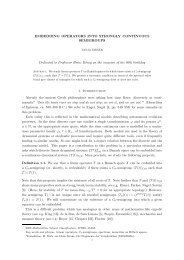Curriculum Vitæ Alessia Gualandris
Curriculum Vitæ Alessia Gualandris
Curriculum Vitæ Alessia Gualandris
You also want an ePaper? Increase the reach of your titles
YUMPU automatically turns print PDFs into web optimized ePapers that Google loves.
• In addition to having large stellar densities, galactic nuclei are believed to contain<br />
massive black holes. Stars on low angular momentum orbits passing close to the<br />
black hole can receive significant velocity changes and be expelled to large<br />
distances. Five stars with extremely large velocities (� 700 km s −1 ), called<br />
hypervelocity stars (HVSs), have been discovered in the last year in the halo of the<br />
Milky Way. In order to test existing theoretical models of these extremely<br />
energetic stars, I performed numerical scattering experiments of encounters<br />
between stellar binaries and the supermassive black hole in our Galaxy. I<br />
investigated the origin of the first HVS discoverd in the halo of the Galaxy and, by<br />
tracing its orbit backward in time in the Galactic potential, I predicted the value of<br />
the proper motion of the star compatible with an ejection from the Galactic centre.<br />
For this purpose, I developed a numerical integrator to solve the equations of<br />
motion of a test particle in the potential of the Milky Way.<br />
• I also studied an additional formation scenario for HVSs involving intermediate<br />
mass black holes (IMBHs). If IMBHs are formed in the Galactic centre region,<br />
they sink toward the centre due to dynamical friction. During the inspiral, the<br />
black holes interact with the surrounding stars and eject some with high velocities.<br />
I performed numerical simulations of the ejection of HVSs by infalling IMBHs and<br />
of their travel in the Galaxy. I explored the possibility of distinguishing between<br />
the population of HVSs created by stellar encounters and the one created by<br />
infalling IMBHs. This might be very important for the search of dynamical<br />
signatures of IMBHs in the Galaxy.<br />
• Dynamical encounters in dense clusters can also involve compact objects: white<br />
dwarfs, neutron stars and black holes. Numerical simulations of star clusters<br />
indicate that most black holes eject each other from their parent cluster in the<br />
early evolution of the system. Alternatively, black holes can receive large kick<br />
velocities during the supernova explosion in which they form, both in a cluster or<br />
in the Galactic disc. Motivated by these findings, I explored the origin of the high<br />
velocity and high galactic latitude black hole X-ray binary XTEJ1118-480. Since<br />
the black hole has a companion star, I combined a kinematic analysis and binary<br />
evolution calculations to investigate the origin of the system. The dynamical<br />
ejection scenario results incompatible with the age of the binary system. As a<br />
consequence, the system must have acquired its large velocity in the supernova<br />
explosion in which the black hole formed. An open question in the study of the<br />
collapse of massive stars to compact objects is the occurrence of asymmetric natal<br />
kicks in black hole systems, similarly to the case of neutron stars (for which there<br />
is observational evidence in pulsars). In the case of XTEJ1118-480, I was able to<br />
put constraints on the velocity of the system at the moment of the ejection from<br />
the Galactic plane by tracing its trajectory backward in time in the Galactic<br />
potential. We found that the standard recoil due to mass loss from a symmetric<br />
supernova explosion cannot account for the large space velocity of the system and<br />
we conclude that an additional asymmetric kick is required during the supernova.<br />
This result has very interesting implications for the understanding of the physical<br />
processes behind the formation of stellar mass black holes.

















